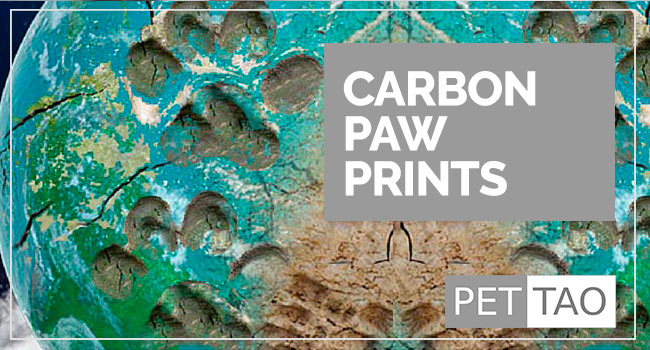Believe it or not, what you eat affects your carbon footprint.
A sustainable food system maintains production and supports itself.
This is harmony.
Using energy releases carbon dioxide into the atmosphere.
A “carbon footprint” is the total amount of carbon dioxide released.
Driving, food production, and powering a gadget releases energy.
Are the humans in your family the only ones who leave a trace?
Think about it: your pet doesn’t drive a car, watch TV, or make any independent decisions!
Well, he still leaves a carbon footprint.
First, Prevent Overpopulation – Spay, and Neuter to Reduce Your Carbon Footprint
Reducing dog and cat overpopulation cut down on carbon emissions. No one person can fix this problem, but you can contribute by spaying or neutering your pet.
There are a few more actions you can take to increase pet food sustainability.
Your choices will help restore balance.
You can negate some of the ways your pet changes the environment with short-term, quick decisions.
The most long-term health-defining daily choice you make for your pets is what you feed them.
Pet Food: the Ultimate Energy Consumption and Carbon Footprint
What pets eat affects the environment, whether you like it or not.
You may be one of those people who choose to recycle an empty kibble bag instead of throwing it away. This is good, but there is more you can do to help.
A long process occurs before the food even gets in the bag.
Pet food production consumes energy through:
- Sourcing
- Extrusion
- Preserving
- Processing
- Packaging
- Shipping
You cannot change this process unless you buy unpackaged pet food.
Your pet has a significant carbon footprint which represents the choices you make for them.
Your choices affect the atmosphere.
How?
Choice #1: Avoid beef and lamb
One easy and quick way to reduce your pet’s carbon footprint is by giving up beef and lamb.
If your pet has eaten beef for a long time, why not switch to a protein with less impact on the earth?
Beef requires a great amount of energy.
It takes 160 times more land to produce beef than to produce grain.
It takes 28 times more land to produce beef than pork or chicken.
Why?
As ruminants, cows do not digest their food as fast as other animals do.
Cows need a similar quantity of food, but they gain less energy from it.
Producing a pound of beef involves producing 13.5 pounds of carbon dioxide.
Which meat requires the most energy to turn into pet food?
Lamb.
Producing a pound of lamb involves producing 20 pounds of carbon dioxide.
Choice #2: Avoid krill oil
Another process impacting the carbon footprint is krill harvesting.
Krill are small crustaceans and are high in EPA and are a good source of Omega-3 fatty acids.
Why would you give your pet krill oil?
You see, your trusted pet food may advertise benefits from Omega-3’s, but you need to know they aren’t preserved well in the bag.
They degrade and are worthless.
Thus, Omega-3’s are often supplemented in the form of fish oil.
Krill are at the bottom of the food chain in the ocean.
The major food source for larger fish becomes extinct as suppliers harvest krill oil.
Overfishing is detrimental to the ocean ecosystem.
Prevent it by avoiding krill oil.
Always try to determine what type of fish your oil came from.
Avoid Menhaden.
Ninety percent of fish oils contain Menhaden oil.
Menhaden will disappear if fishing continues at this rate.
Choose a vegetarian source of Omega-3s rather than a marine source if you can’t figure out where the ingredients came from.
Vegetarian supplements containing Omega-3s include flaxseed oil, safflower oil, chia seeds, and hemp seeds.
Voting for sustainability with your wallet is simple and easy.
Choice #3: Choose vegetarian glucosamine
Another process affecting the ocean ecosystem is shark harvesting. Glucosamine supplements include shark fin cartilage. Chitin from shellfish is also used.
Glucosamine is a compound found in connective tissue (especially cartilage) and the fluid surrounding joints.
Glucosamine supplements are one of the most commonly taken by humans for osteoarthritis pain.
As glucosamine becomes more popular, the number of sharks declines.
Over the past 40 years, many species of sharks have become endangered. Some populations declined by 87-99%. Suppliers harvest blue sharks for their cartilage more often than other sharks.
Did you know there are vegetarian and vegan ways to get glucosamine?
It’s true!
Glucosamine is also sourced from vegetables like corn. Both animal and plant sources contain Glucosamine and the compound is the same.
Glucosamine from corn benefits humans with shellfish allergies.
Glucosamine from corn benefits shellfish and shark populations even more!
You can support a sustainable ocean
Buy alternatives to beef, lamb, krill oil, and glucosamine sourced from the sea.
It’s easy!
If you make these simple switches for you AND your pet, you will support the ecosystem.
You will help restore balance and harmony to the earth, even if you cannot see it yet!








